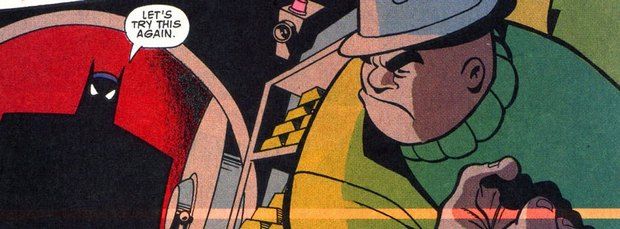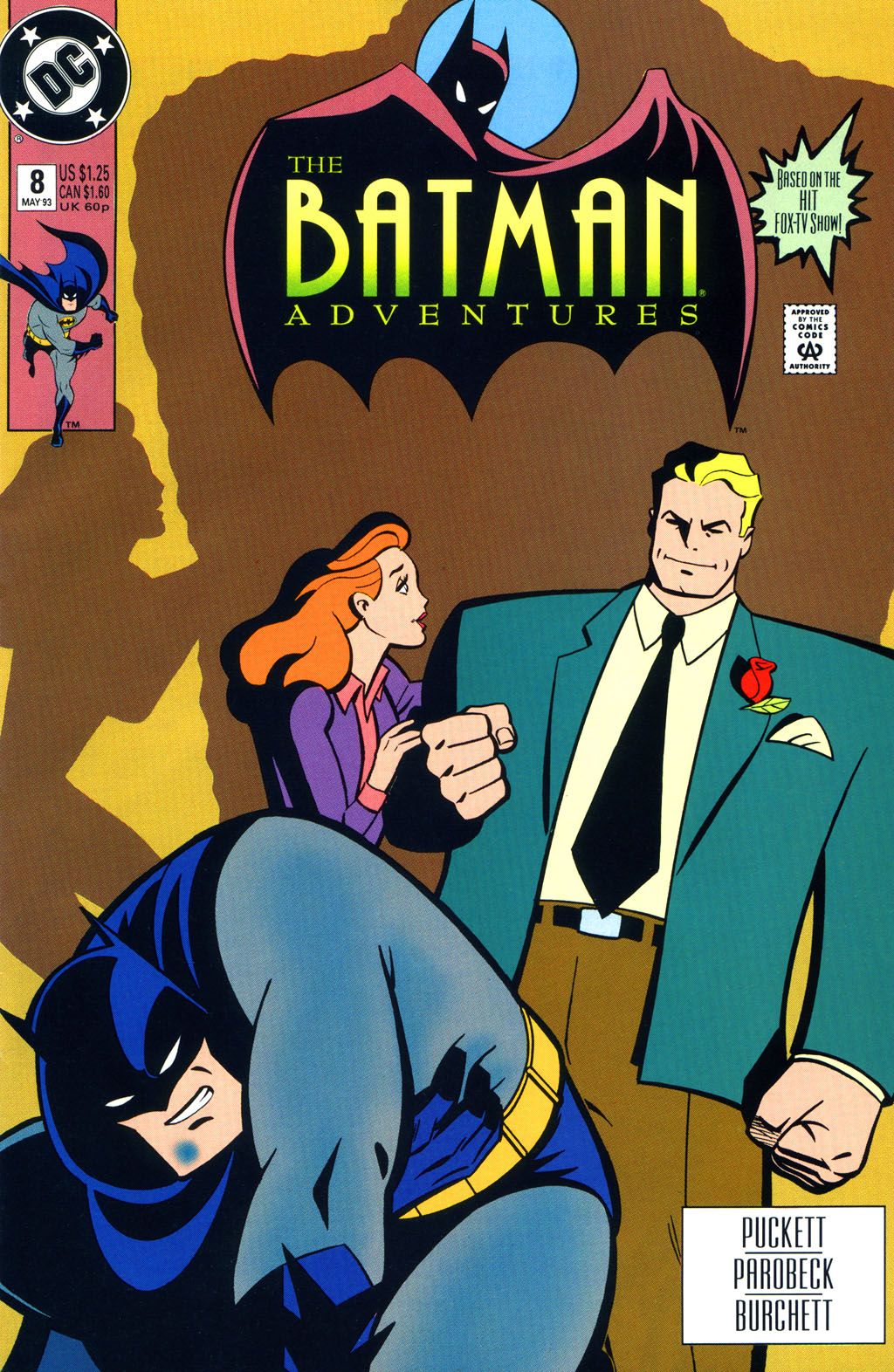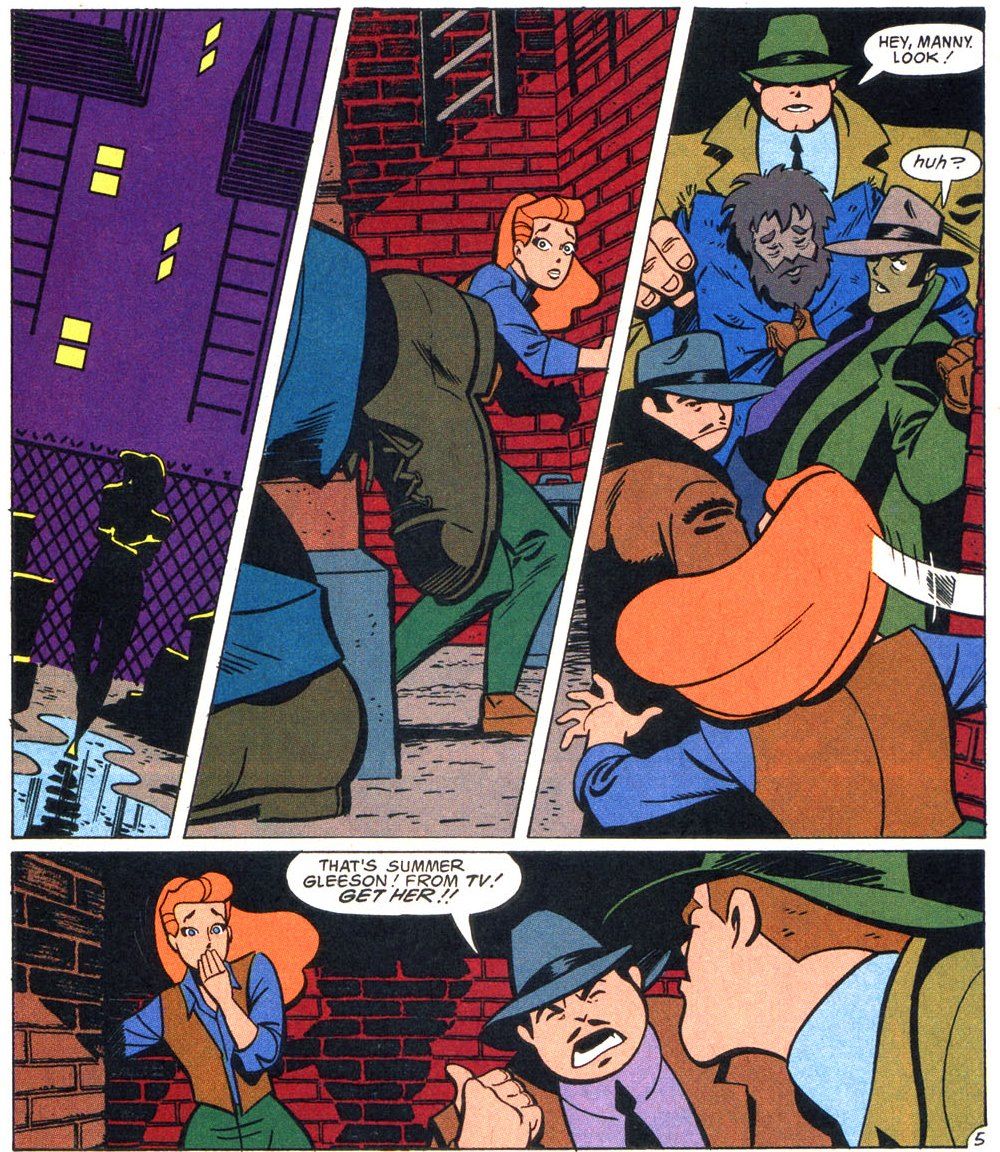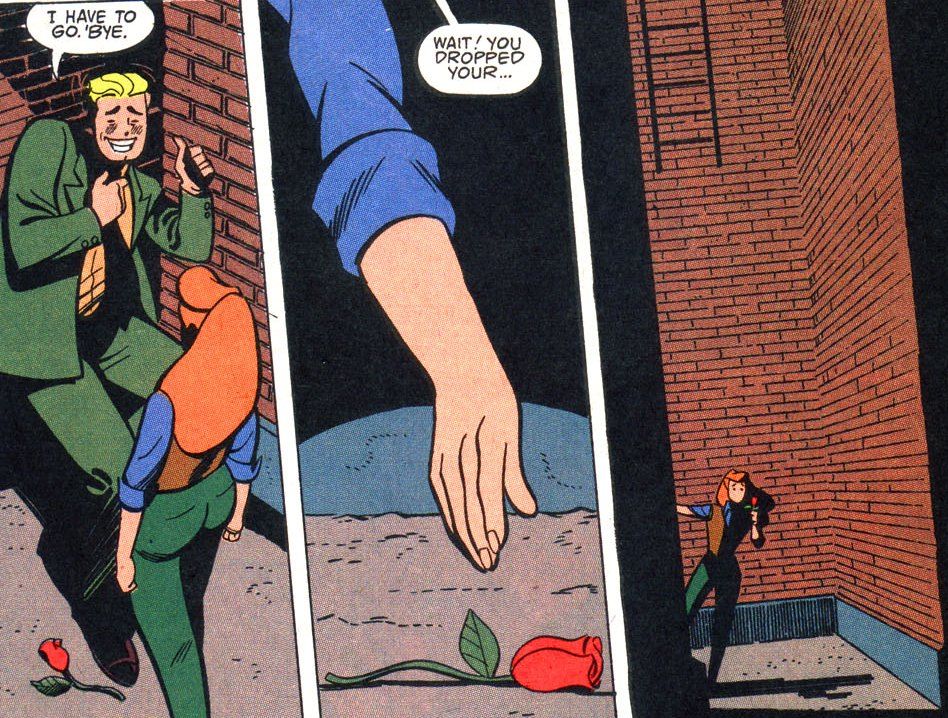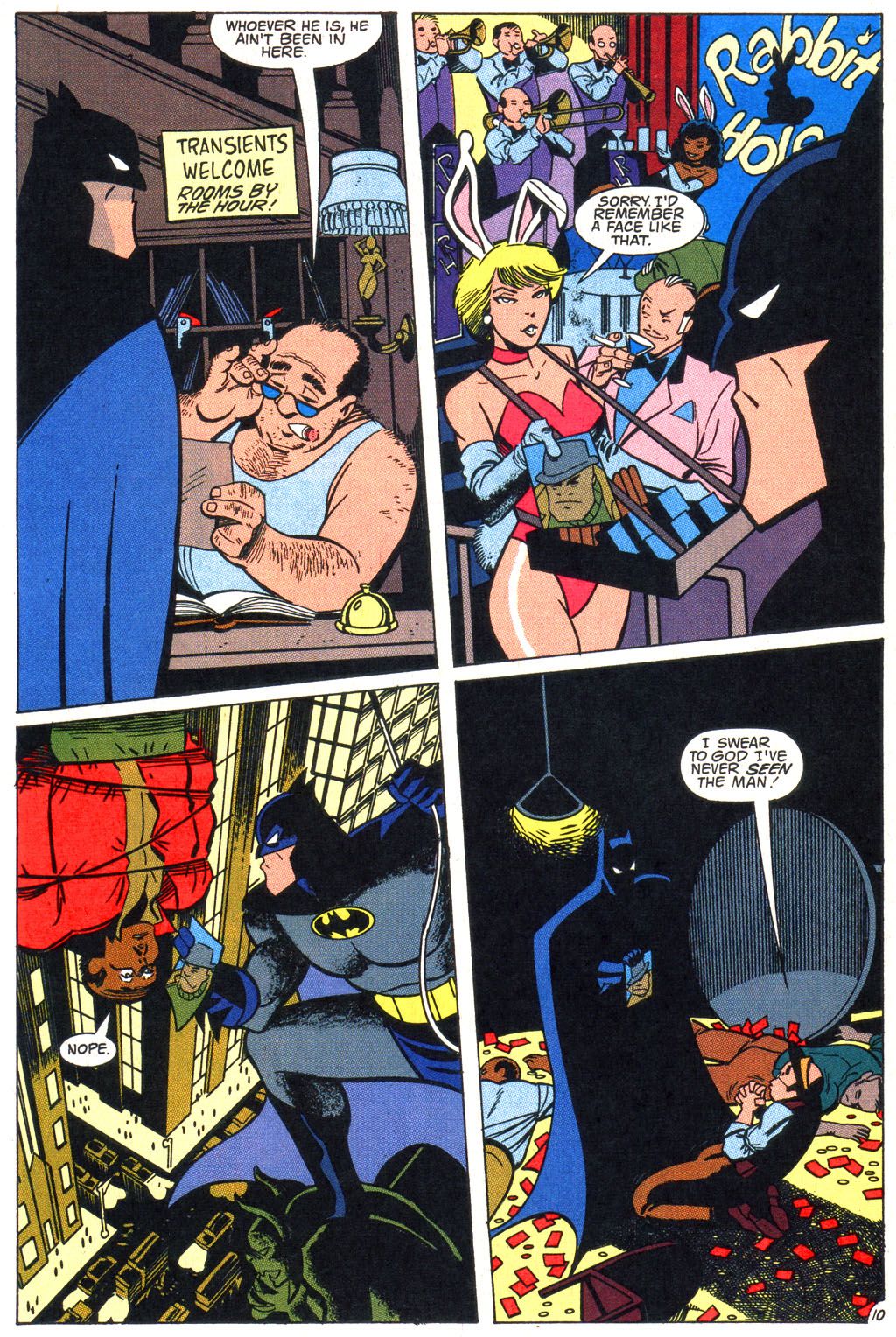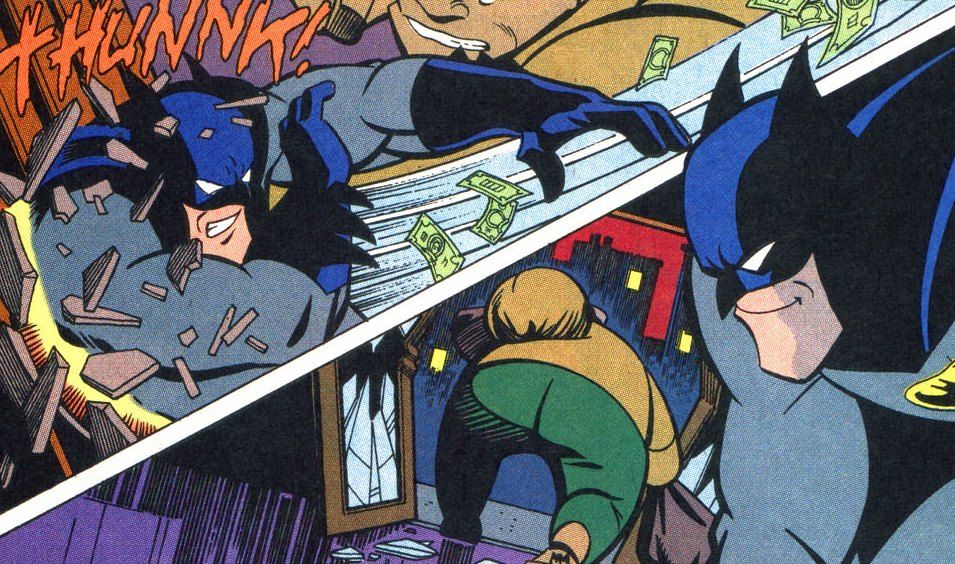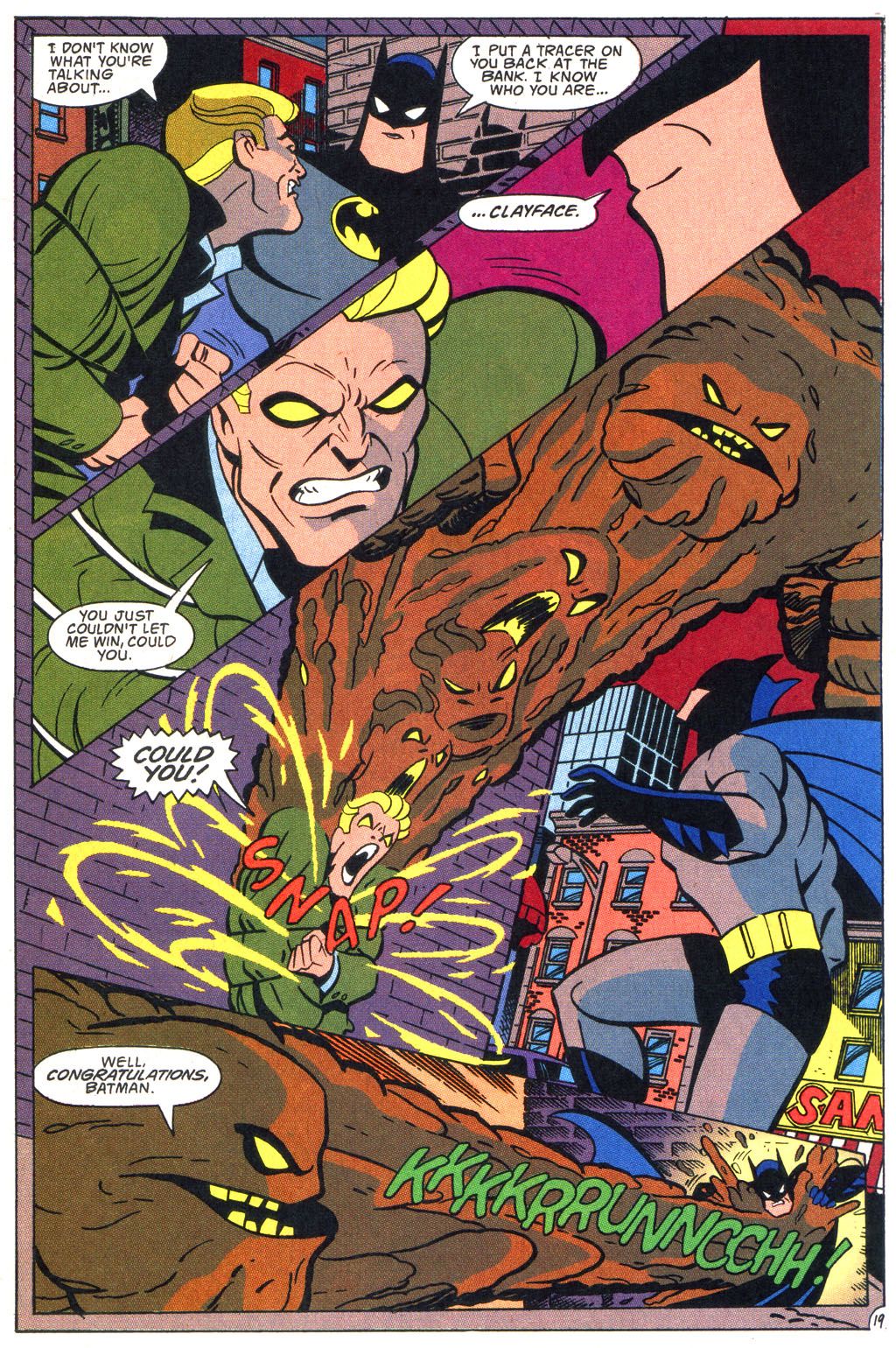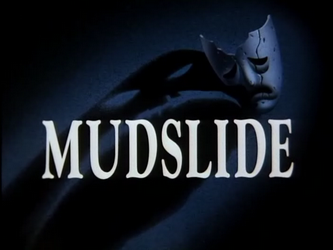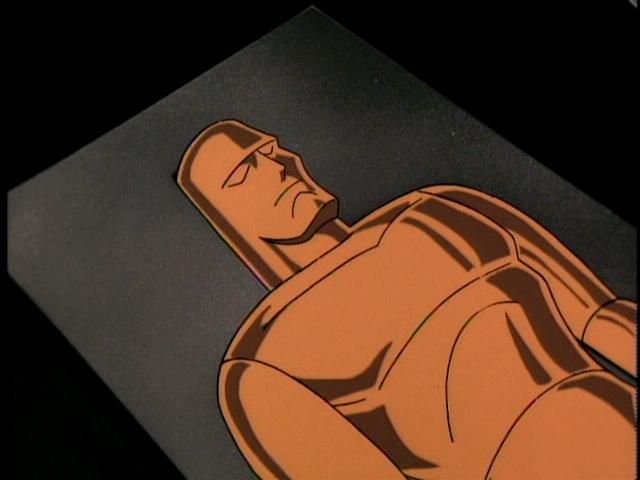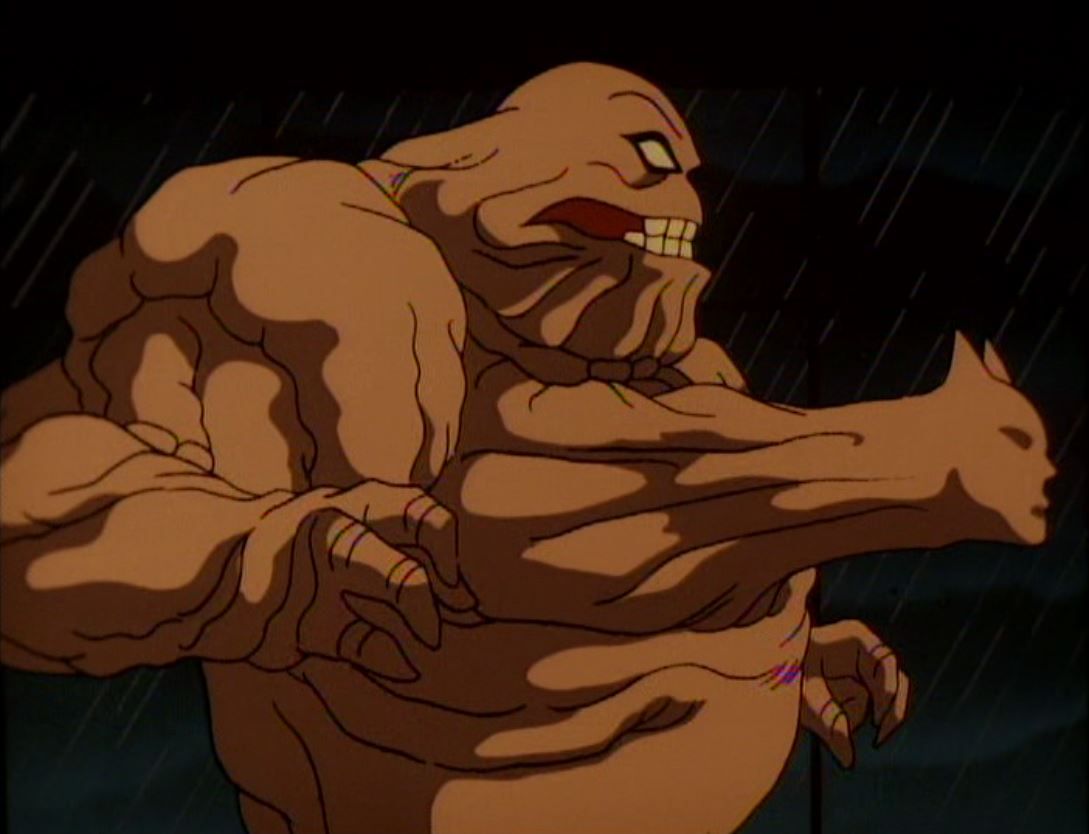Welcome to the second installment of Adventure(s) Time, where I examine a classic episode of Batman: The Animated Series, and an issue of its comic tie-in, Batman Adventures, that shares a similar theme.
Today, we’ll go back to the May 1993 issue of Batman Adventures (“Larceny, My Sweet”), which features a story by Kelley Puckett and early work from the great Mike Parobeck. Parobeck passed away in his early 30s, leaving only a few years of work as his legacy, but he’s regarded by many as the finest artist ever to work in this style. According to his interviews, Parobeck had no specific interest in comics, outside of a deep admiration for John Byrne. How exactly he developed his simplified, heavy-yet-smooth style, I’m not sure, but it was developed independent of Bruce Timm’s work on Batman: The Animated Series. If you check out Parobeck’s work on Justice Society of America, you’ll see that his natural style was already broadly consistent with the look of the animated Batman, even before he was hired for this job.
One element that Parobeck retained in his Adventures work, which never made its way into the animated series, is the John Byrne influence. If you look at the handsome blond man on the cover, that face is obviously inspired by Byrne…and even if Byrne didn’t influence the cartoon, the figure’s not out-of-place with a design you might see on the show. Since random characters on Batman: The Animated Series could be caricatured in various ways, seeing a guy with a John Byrne smile wouldn’t be any more outrageous than those extras who looked like they arrived from Tiny Toons.
The issue opens with Batman confronting “The Invisible Man,” so named for his ability to disappear from any crime scene. TV reporter Summer Gleeson is also on the job, but her pursuit of the Invisible Man leads her into a dangerous back alley.
She’s rescued, not by Batman (who’s still recovering from the beating handed to him by the Invisible Man, who’s actually very visible if you meet him in person) but by a mysterious blond stranger. He rescues her, checks to see if she’s okay, and sparks fly. The Good Samaritan is apparently shy, however, because he flees as soon as possible, leaving behind the rose that was knocked from his lapel during the fight.
Summer is smitten with the mystery man, but has no means of contacting him. I’m not going to argue that this issue is a fantastic character study of Summer, but she does have more personality here than I recall her exhibiting on the animated series. It seems that the creators of the show had some plans to make Summer a significant part of the series, given her ubiquitous presence in the early episodes (and her appearances in some of the early promo art), but I can’t recall her playing a substantial role in any episode. Is there one out there I’m forgetting? My memory is that Summer is the standard TV reporter we see in the early episodes (I think there’s even some suggestion, maybe in the early promotional material, that she’s eager to learn Batman’s secret ID), who then only makes sporadic appearances before disappearing. I’m not even sure if she received a revamped character model for the New Adventures episodes.
As the story moves on to Act II, Summer is pining for the mystery man while Batman is hitting the underworld for information on the Invisible Man. Interestingly, Alfred asserts that Batman wouldn’t normally be so concerned about a bank robber. Batman even agrees, but states that Commissioner Gordon’s putting his career on the line to find this guy and is coming up with nothing, so he’s obligated to help. I guess at this stage, Kelley Puckett was under the impression that the animated series would exclusively focus on supervillains with grand plots instead of more realistic crimes. Was he not informed early on that mobsters were going to be recurring villains for the series? (At least during its initial run on FOX.)
Regardless, here’s a nice montage of Batman interrogating various underworld types. Notice how much story is conveyed in only four panels.
Eventually, the thief strikes again and has another confrontation with Batman. The hero suffers his second defeat of the issue, but the final panel indicates that he’s not broken up about it.
Act III opens with good news for Summer -- her shy mystery man has mustered up the courage to call her and invite her on a date. While he waits for her to arrive at the restaurant, he’s given a message from the waiter that he has a phone call. (This brief scene indicates one of the strengths of the non-time aesthetic. Looking back on the issue over twenty years later, there’s no justification for picking apart the portrayal of technology of this time. The men are wearing zoot suits and the cars are circa WWII. And yet, there are computers, 24-hour news channels, and even virtual reality games. It doesn’t make literal sense and it doesn’t have to. So the phone the mystery man uses in the restaurant just looks like A Phone, one that might’ve been operational at any time in the late twentieth century.)
The phone call is merely a diversion, as Batman wraps the handsome stranger up in a rope and drags him out of a nearby window. In-between panels, he’s discerned the mystery man’s secret (with the help of the tracer he planted on the Invisible Man earlier). The handsome stranger and the brutish Invisible Man are in fact the same man…because they’re both Clayface.
Summer Gleeson arrives just moments after her crush changes shape, receiving a firsthand account of Batman’s latest battle with Clayface. Since the story only has a few pages left, Clayface puts up perhaps his weakest showing in this continuity -- Batman’s able to take him down by merely releasing some sort of sonic scream from his belt. (He never tells Summer to cover her ears, by the way.)
Clayface is hauled away in a police van, while Summer asks Batman if he’s seen her handsome admirer. “No, Miss Gleeson. The person you described…was never here” is his response, while the “camera” shifts to the rose Summer salvaged from the alley, now a piece of brittle clay.
And if that isn’t a classic Animated Series ending, then I’ve never seen one. You can practically hear one of Shirley Walker’s scores in the background. This easily could’ve been adapted as a Clayface episode, but given that the producers were reluctant to do Clayface stories (and pretty much disregarded any issues not written by Paul Dini), I’m not surprised the story remained exclusive to Adventures.
This leads us to our pick for the issue’s thematic cousin, and this time we’re going with the second season episode “Mudslide.” It’s another story that opens with Clayface impersonating someone during a robbery, before introducing us to a woman harboring deep affection for the monster.
(I was also tempted to go with “Growing Pains,” because it’s another story that doesn’t reveal that a mystery figure is actually Clayface until the end, but I’d like to hold off on New Adventures episodes for now.)
Originally airing on September 15, 1993, “Mudslide” features a teleplay by Steve Perry, a story by Alan Burnett (one of the fathers of the DC Animated Universe), and is directed by Eric Radomski, who developed the show along with Bruce Timm. You might remember that The Animated Series rarely did Clayface episodes, apparently because they were so difficult/expensive to animate. Clayface’s transformation sequences were no easy feat for the animators, and according to Bruce Timm, one of the few times he ever exercised his power to rearrange animation studios occurred when the original Clayface two-parter was slated to have the climax animated by AKOM, the weakest studio assigned to the show. Timm made sure that AKOM animated the set-up episode, and TMS (viewed as the finest studio utilized by the show) was assigned the episode that actually featured Clayface’s elaborate transformations. “Mudslide” was apparently conceived as a response to fans’ requests for more Clayface.
The episode opens with a security guard encountering his sinister twin, who takes advantage of his appearance to rob Tarnower Financial. Of course, we all know that the “twin” is Clayface, even though the episode tries to maintain this mystery for the first few minutes. This is an instance where the comic has an advantage over the cartoon -- the title card “Mudslide” is clearly telling you who the villain is minutes before the reveal. The comics have the equivalent of a title card in the form of their covers, but the mystery isn’t spoiled by the Adventures cover (unless you study that shadow closely). Regardless, Batman arrives to stop the robbery, discerns the thief’s true identity, but is unable to prevent Clayface from escaping with the aid of a mystery female.
While examining a piece of clay left behind by Clayface, Batman learns that his body is disintegrating. Notice in this scene just how chatty Batman and Alfred are, a reminder that the more somber Batman many remember from this series doesn’t appear until much later in the run. Without any sidekicks around, Batman has to carry many of the conversations. The exposition has to be established of course, but also, the scene isn’t going to have any personality if Batman and Alfred aren’t chummy with one another.
Meanwhile, the mysterious Dr. Stella Bates is literally pouring Clayface into a plastic shell that’s designed to keep his body together. The slender, square-head interpretation of Clayface evokes not only one of his looks from the comics (without the cape, obviously), but also that of the Oscar statuette. Considering that this interpretation of Clayface is a disgraced former actor, surely this wasn’t an accident. I can understand why Clayface needs to change his look in these scenes, but as a kid, I was concerned that this was a permanent redesign of the character and that the cool blob monster was gone.
Stella informs Clayface of an isotope called Mp40, which will not only restore his body but also allow Clayface to permanently become Matt Hagen again. As sheer plot convenience would have it, the isotope just so happens to be located at Wayne Biomedical Labs.
It’s not hard to guess what happens in the next scene, but it does lead to a cool chase sequence that has Batman pursuing Clayface to a train station, where they fight inside one of the cars, and we’re confronted with one of the strangest Clayface moments ever -- Batman literally kicks his head through his butt, and Clayface responds by morphing his butt into his head. I’m sure the censors loved that one.
Eventually, Batman deduces the identity of Clayface’s female aide (after guessing that she was a technical advisor on one of his films…and consulting a film directory to learn her identity, because there’s no IMDB.) Dr. Stella Bates has been in love with Matt Hagen for years, and out of misguided affection, she’s dedicated her life to restoring the Hagen she remembers. Batman confronts the couple at her cliffside home, and rather callously cuts off the Mp40 treatment. Naturally, this leads to another fight scene. This time, Clayface swallows up Batman, who doesn’t go down easy.
Eventually, Batman escapes by using his rope gun to blow Clayface’s head off. This is one of the advantages of using Clayface in the cartoon -- pretty much anything you do to Clayface won’t kill him, so you end up with insane sequences like this.
Soon, the battle is taken outside, where the rain continually erodes Clayface’s ailing body. (Ironically, Batman keeps offering to help Clayface, even though he’s just shut off the treatment that Wayne Biomedical would’ve used to help keep Clayface alive.) They tumble off the cliff, Batman tries to rescue Clayface, but the villain accepts his fate and allows his dissolving body to fall into the water. It’s a fairly convincing death scene, until you remember that Clayface also “died” at the end of his first appearance on the show.
The Wrap-Up
Design-y: Stella’s home overlooking the crashing ocean has a nice look. I also like Mike Parobeck’s interpretation of the Gotham cityscapes, even though there’s no way the comic could present the kind of painted backgrounds we saw on the cartoon.
Continuity Notes: When Clayface returns in the “Growing Pains” episode, a flashback explains how he survived the climax of this story. (“Mudslide”)
Over the Kiddies’ Heads: Psycho and A Streetcar Named Desire are both referenced, with the revelation that Dr. Bates once owned a motel, and with Clayface’s exaggerated “Stella!” cry. (“Mudslide”)
Battle of the Cliffhangers: Bizarrely, the structure of both stories don’t allow for any particularly great cliffhangers. I’ll call this one a draw.
Battle of the Unlikely Clayface Love Interests: I’ll side with Summer Gleeson, if only because it’s one of the very few times she’s the focus of a story, so we’re ready to learn more about her. Stella, meanwhile, is essentially a plot device.
Thanks to commenter GastonJacques for suggesting this Clayface issue of Adventures as a nice companion for “Mudslide.” If you have a suggestion for Adventures stories with a thematic connection to an animated episode (any Adventures series, not just Batman) let me know in the comments section. Until then…
Yeah, Shut Up. on Noisetrade || Not Blog X || Twitter || The (David) Milch Studies on Real Gentlemen of Leisure || Tumblr

